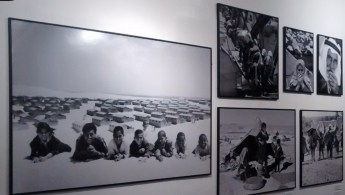Revisiting Palestine's long journey
Millions have been displaced in the Middle East in recent years following wars in Syria, Iraq and Palestine.
But this is a recurring problem in a region buffetted by wars and displacement over many years, as an exhibit in New Yorkl organised by the United Nations Relief and Works Agency (UNRWA).
Tapping into five decades of refugee life, The Long Journey documents one of the region's most tragic of these displacements. Through photographs and videos the exhibition documents the 1948 Nakba from a human perspective, when more than 850,000 Palestinians were
| This rich archive consolidates this component of the Palestinian identity by recounting the shared experience of the refugees. - Filipo Grandi |
expelled from their homes to make way for the establishment of the state of Israel.
The exhibition showcases the first part of UNRWA's newly digitised archive, comprising over 430,000 negatives, 10,000 prints, 85,000 slides, 730 video cassettes, and 75 films.
Through a carefully chosen selection of audio-visual material we are given a profound insight into the hundreds of thousands of Palestinian refugees who were forced to start to rebuild lives in Lebanon, Syria, the West Bank and Gaza.
Mona Abu Rayyan, executive director at Alwan for the Arts Centre spoke about the significance and timing of this exhibition in New York.
"Since violence escalated in Gaza last year, we had wanted to do something such as holding a fund raising event. We wanted to help out in any way that we could, and when the opportunity arose to showcase the exhibition in New York, we were delighted to offer our space here," she says.
She says that The Long Journey is of great importance as it communicates the suffering and strength of the Palestinian people.
"It is crucial that we bring this to public attention here in New York," she says.
The Long Journey has been on display at the United Nations General Assembly, but there it could attract only "a relatively select audience", Mona says, due to tight security measures in place.
The exhibition at Alwan for the Arts is by contrast free and open to the public.
A number of the photographs at the exhibition have already been sold, and on the final day of the exhibition an auction will be held with all the proceeds going to UNRWA's emergency relief fund for Gaza.
The outstanding historical value of this digital archive is being recognised by its inclusion into UNESCO's 'Memory of the World' register.
UNRWA's commissioner-general, Filipo Grandi, said the exhibition is an important example of collective memory that is a vital component in sharing one's identity, in this case Palestine's.
"This rich archive consolidates this component of the Palestinian identity by recounting the shared experience of the refugees," he said.
"For us, the matter was also quite urgent from a technical perspective: we had to do something with the overwhelming volume of material we had, which was in danger of gradually wearing away with time."
Grandi says that the digitised system was the only way of preserving these shared memories for future generations.
Alwan for the Arts is an artistic and cultural centre, established in New York in 1998. Through voluntary initiatives it aims at establishing dialogue and improving understanding between American and Arab cultures through a range of artistic and cultural events.
The Lost Memory will be on display 12 February.
This article is an edited translation from our Arabic edition.



